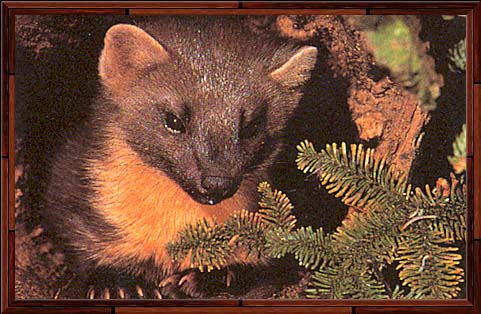
The Pine Marten
Martes martes
The pine marten was once quite common throughout Britain. Now it is uncommon and found mainly in remote forests or sometimes on rocky moorland where it spends quite a lot of time on the ground looking for food in forest rides and grassy areas. Prime habitats for pine martens seem to be well wooded areas, with high densities of voles that are their principal prey. Martens have a very varied diet, which changes with the seasonal availability of different foods. Small rodents are a very important food, but birds, beetles, carrion, eggs and fungi are also eaten. In autumn, berries are a staple part of the diet. Martens mostly hunt on the ground, although they are superb climbers and extremely agile.
Recognition:
Dark brown fur with a yellow/white throat patch and a long fluffy tail.
Head/body length: males 51-54cm; females 46-54cm;
Tail length: males 26-27cm; females 18-24cm.
Weight: males 1.5-2.2kg; females 0.9-1.5kgBiology:
Pine Martens breed once a year, mating in July or August. But there is a delay in the implantation of the fertilised egg, and females do not become pregnant until about January. A litter averages three babies, born in March or April in a den usually in a crevice in the rocks or tree roots. The young spend at least six weeks in the den before their eyes open and they are big enough to venture out, and the family stays together until they are about six months old. The youngsters grow quickly and reach adult size in their first summer, but until their first winter moult they have a paler, woollier fur than their parents. Female pine martens with young are extremely sensitive to human disturbance, which can cause a female to move her young from a den or even eat them. Pine martens have lived up to 17 years in captivity
Martens have territories that vary in size according to habitat and food availability. For males these are about 10-25 square kilometres and for females about 5-15 square kilometres. Martens mark their territories with faeces (known as scats) deposited in places where they are conspicuous to other martens; they are frequently left along forestry trails.